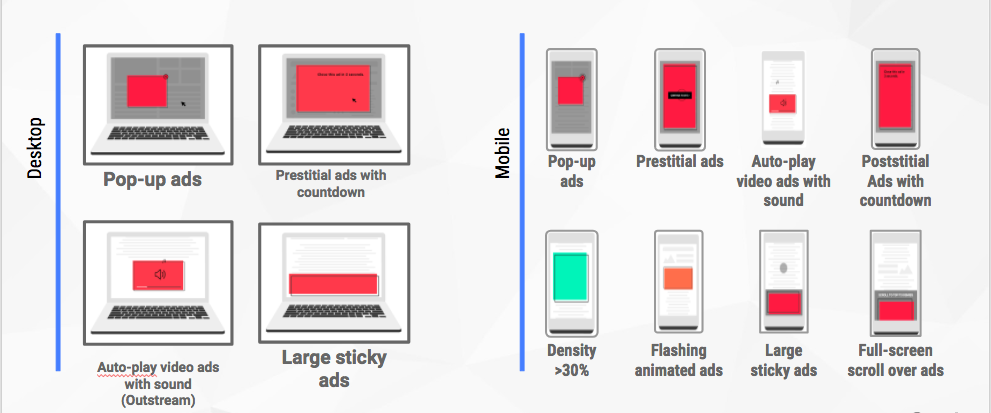Display ads 101
An intro guide to display ads: what you need to know about display advertising, pros and cons, and how to make sure you do them well.
Author
Date published October 5, 2018
Categories: Display Advertising
This is an updated version of our popular “A beginner’s guide to display advertising” from 2015.
Digital marketing is full of buzzwords so overused they’ve all but lost their meaning, like “authentic experiences” and millennials. Yet, the industry is also full of jargon that does mean something, but has so many different interpretations it can often be difficult to understand.
One of these common misinterpretations is around display advertising and the idea that any and all online marketing is considered display. It’s not. Native ads are sometimes content marketing, and they are sometimes display ads, though not always. Confused?
So what is a display ad?
Display ads are the boxes on websites that are obviously advertising. They can be along the top of web pages such as the traditional banner ad, or the larger text billboard. They can also be videos. These types of ads appear on distinct sections of the site that are specifically reserved for paid advertising and are aimed at generating a quick conversion.
For example, this ad for Jet.com on The New York Times‘ homepage. Is there any doubt in your mind that this is an ad?
The wider banner ads generally perform better than their tall, narrow counterparts. According to Google, the most effective display ads are the 300×250 pixel rectangles. They translate well to mobile devices and work best when embedded in content.
Other well-performing ad sizes are the slightly-larger 336×280 pixel rectangles, 300×600 pixel half-page ads, and 728×90 leaderboard ads. Jet.com is an example of the latter. On mobile devices, Google also recommends the 320×100 ads that are about double the size of a typical mobile leaderboard.
Display versus native
On the other hand, native ads are designed to blend in with their surroundings. Both are paid opportunities but, by fitting in seamlessly on the pages on which they’re placed, native advertising is thought to be less disruptive. They’re common on digital magazines and on social platforms like Instagram.
If you’re just casually scrolling, you might see this and think, “Oh, Rob Lowe is friends with Dr. Oz.” But the location tag under his handle, as well as the hashtags in the caption, lets you know that this is actually an ad.
Content marketing can be considered native advertising, though it is only display in some forms. For example, branded infographics and videos, when positioned neatly in an article, can fit into the display bracket – specifically when they are paid for by an advertiser.
Other content marketing formats such as blogs, articles, reviews, and whitepapers, however, are not display advertising. Their purpose is to create a value exchange with the consumer with useful, interesting, and targeted information.
OK, got it. Are there any other kinds?
Not all display ads fit neatly into one of those boxes. Other common formats for both static and video ads include:
- Rich media:There are a few varieties of rich media ads. One is the video that unexpectedly starts as the page loads, alerting everyone in earshot that you’re not actually working. The more polite versions of rich media ads just sit quietly on the page until you roll over them with your mouse. Then they expand, like the push down ads that move content downward as you scroll.
- Interstitial:An interstitial is the full-screen ad that pops up in between activities, such as clicking from one page to the next or getting to the next level on a page. Platforms like Pinterestand Yelp used to use them to drive app downloads, though Google put an end to that practice in 2016. Today, they’re more commonly seen in between levels on a game, like this Nike ad I got on Words With Friends.
- Overlay:An overlay is similar to an interstitial in that both pop up and must be X’d out, in order to see the content. However, an overlay is often transparent and allows you to see what’s behind it.
What are the pros and cons of display ads?
Like anything else, display ads come with their own set of pluses and minuses. On the one hand, everything above illustrates the flexibility. There are countless combinations of formats, sizes, and styles, allowing you to mix it up.
Display ads also travel far, given the millions of websites reached by Google’s Display Network. The search giant can match your ads up to websites and apps based on keywords or your own targeting preferences.
They’re also fairly straightforward to measure. Display advertising analytics allow you to track the number of clicks, impressions and conversions the ad has generated in real-time, giving you an up-to-date picture of what is resonating with consumers.
But while display ads are so widely used, they’re also widely ignored. Because display advertising is everywhere, people tend to develop a bit of ad blindness. As a result, the average click-through rate across all formats is less than one percent.
There’s also the issue of ad blockers. Last year, eMarketer predicted that 30% of Internet users would deploy ad blocking software by the end of 2018.
Cool. So, like… how do I do it?
Now that you have a better understanding of display advertising and its pros and cons, here are a few tips to apply to your execution.
- Be wary of being interruptive. Disruptive ads are often considered the catalyst for the high rate of ad blockers around the world. In February, Google began filtering outsome of the worst offenders for Chrome users.
- Be visually stimulating. Think of a display ad the way you think about an infographic: less is more. You may want to cram everything you deem important into your ad, but you definitely should not do that. Your ad will be visually overwhelming and too busy to catch anyone’s eye, and ultimately fall victim to ad blindness.
- Be experimental, yet complementary. There are so many different display ad formats that it makes sense to dabble and see which ones work best for you. However, if they’re consistent and look like “they go” with your other marketing, people will be more likely to associate your company, even if it’s just subconsciously. Think of Lululemon. All of the brand’s marketing has such a distinct aesthetic that’d be recognizable even without the name “Lululemon” anywhere.
- Be direct. What are you looking to achieve? Unless the goal of your campaign is strictly branding, you should include an obvious call-to-action. For example, the Jet.com ad includes the word “Shop.” You can’t get more direct than that.
Ref: www.clickz.com




